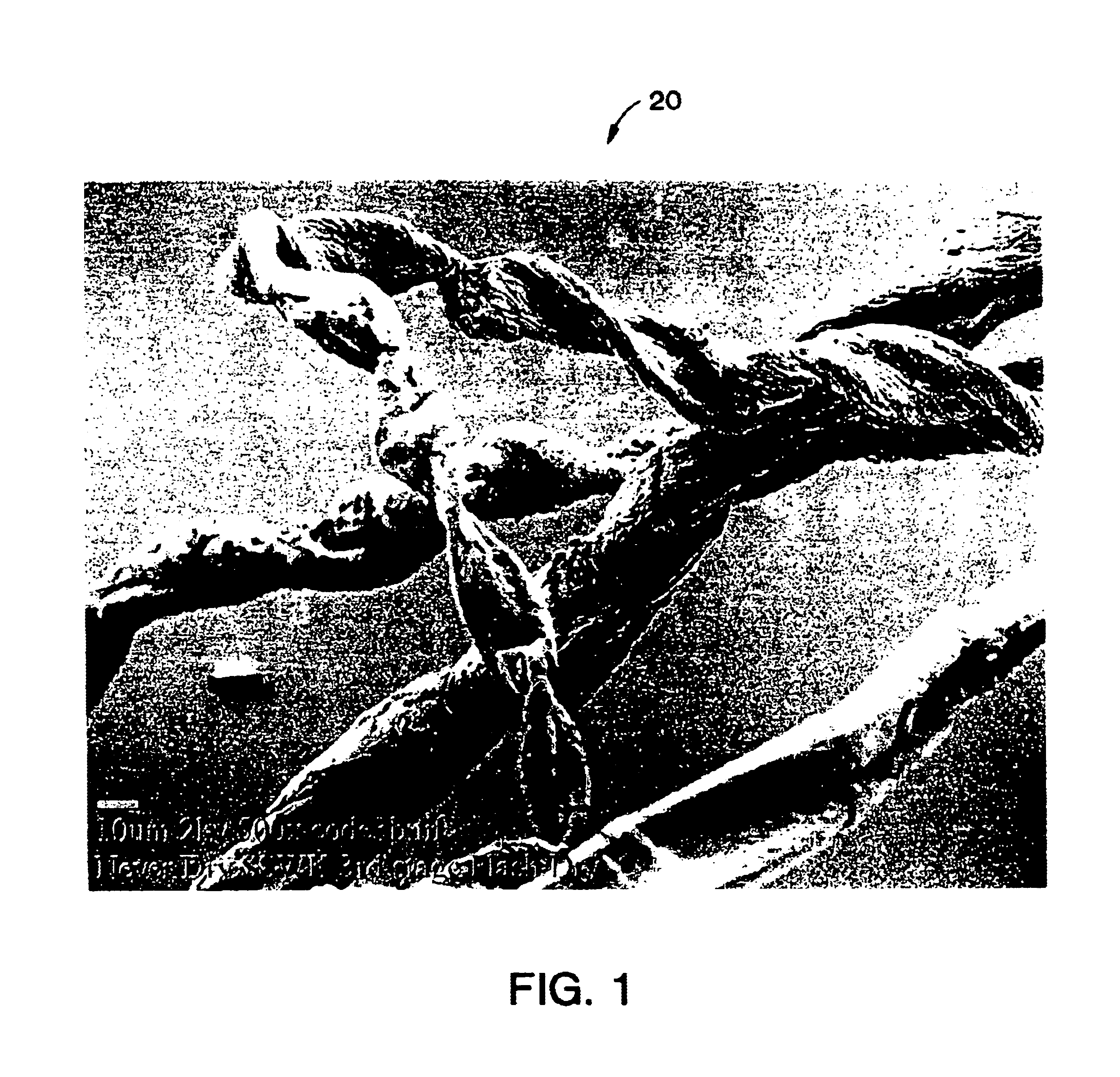Wood pulp fiber morphology modifications through thermal drying
a technology of thermal drying and fiber morphology, which is applied in the direction of application, bandages, transportation and packaging, etc., can solve the problem of increasing the degree of non-uniform fiber shrinkage inducing the formation of fiber coils
- Summary
- Abstract
- Description
- Claims
- Application Information
AI Technical Summary
Benefits of technology
Problems solved by technology
Method used
Image
Examples
example 1
Flash Drying a Rewet Southern Softwood Kraft Fiber
A dry southern softwood kraft fiber (CF 416, available from Weyerhauser Co. of Federal Way, Wash., U.S.A.) was made into a slurry and was dewatered to 15% consistency. Then the fiber was fed into a lab scale 2-inch by 2-inch Flash Dryer with 5 to 10 pounds per hour water evaporation capacity (available from Barr-Rosin Inc. of Bolsbriand, Quebec, Canada). The operations were conducted as follows:1st stage: Inlet temperature 620 degrees Fahrenheit Outlet temperature 350 degrees Fahrenheit Outlet consistency 32.6%2nd stage: Inlet temperature 460 degrees Fahrenheit Outlet temperature 250 degrees Fahrenheit Outlet consistency 88%3rd stage: Inlet temperature 460 degrees Fahrenheit Outlet temperature 250 degrees Fahrenheit Outlet consistency 97.2%
The Water Retention Value (WRV) and number of fiber twists per millimeter are provided in Table 1, below.
example 2
Flash Drying a Never-Dried Southern Softwood Kraft Fiber
A never-dried southern softwood kraft fiber (CR-54, available from Bowater Co. of Coosa Mill, Ala., U.S.A.) was made into a slurry and was dewatered to 19% consistency. Then the fiber was fed into a lab scale 2-inch by 2-inch Flash Dryer with 5 to 10 pounds per hour water evaporation capacity (available from Barr-Rosin Inc. of Bolsbriand, Quebec, Canada). The operations were conducted as follows:1st stage: Inlet temperature 620 degrees Fahrenheit Outlet temperature 350 degrees Fahrenheit Outlet consistency 58.2%2nd stage: Inlet temperature 460 degrees Fahrenheit Outlet temperature 250 degrees Fahrenheit Outlet consistency—not available (NA)3rd stage: Inlet temperature 460 degrees Fahrenheit Outlet temperature 250 degrees Fahrenheit Outlet consistency 92%
The Water Retention Value (WRV) and number of fiber twists per millimeter are provided in Table 1, below.
example 3
Spray Drying / Flash Drying a Never-Dried Southern Softwood Kraft Fiber
A never-dried southern softwood kraft fiber (CR-54, available from Bowater Co. of Coosa Mill, Ala., U.S.A.) was made into a slurry at 0.2% consistency. The slurry was treated with 0.04% Adogen (cationic surfactant) and 0.2% aerosol (anionic surfactant) sequentially. The surfactant treated fiber was fed to a spray dryer with 120 to 155 pounds per hour water evaporation capacity (available from Barr-Rosin Inc. of Bolsbriand, Quebec, Canada). The operations were conducted as follows:Inlet temperature of 440 degrees Fahrenheit and outlet temperature of 191 degrees Fahrenheit. A wheel atomizer was operated at 17.8 K rpm with an air flow rate of 1650 ACFM. The outlet consistency was about 23%. The spray dryer partially dried fiber was fed into the flash dryer as described in Example 1 and its operation conditions were as follows:1st stage: Inlet temperature 562 degrees Fahrenheit Outlet temperature 375 degrees Fahrenheit...
PUM
| Property | Measurement | Unit |
|---|---|---|
| contact angles | aaaaa | aaaaa |
| total volume | aaaaa | aaaaa |
| temperature | aaaaa | aaaaa |
Abstract
Description
Claims
Application Information
 Login to View More
Login to View More - R&D
- Intellectual Property
- Life Sciences
- Materials
- Tech Scout
- Unparalleled Data Quality
- Higher Quality Content
- 60% Fewer Hallucinations
Browse by: Latest US Patents, China's latest patents, Technical Efficacy Thesaurus, Application Domain, Technology Topic, Popular Technical Reports.
© 2025 PatSnap. All rights reserved.Legal|Privacy policy|Modern Slavery Act Transparency Statement|Sitemap|About US| Contact US: help@patsnap.com

